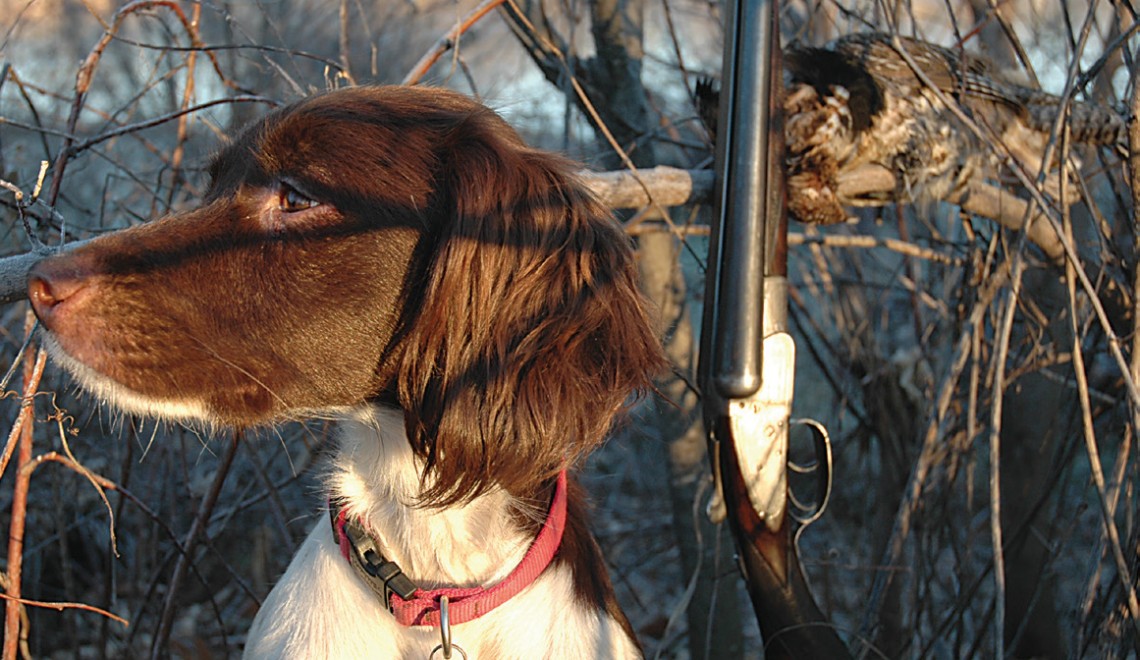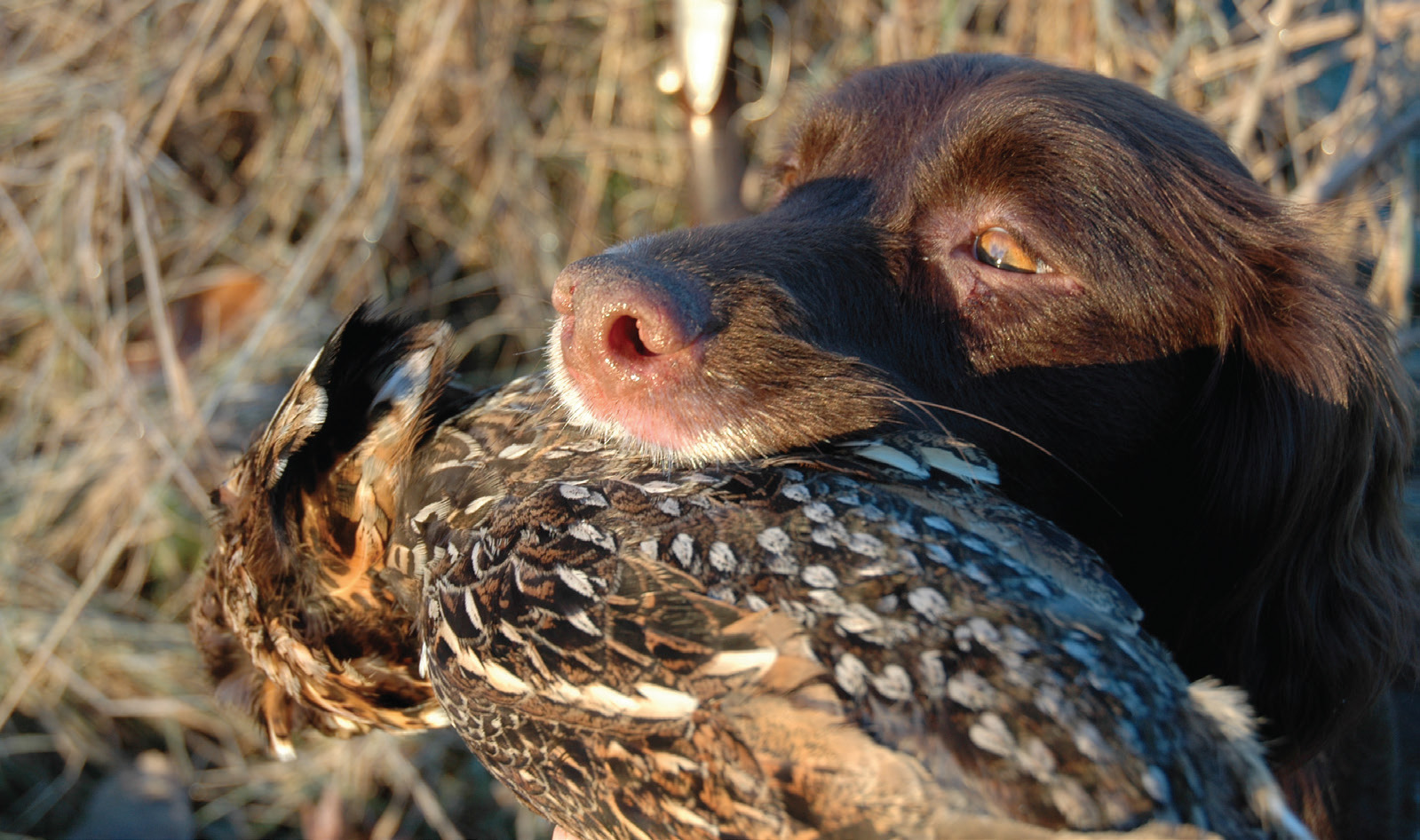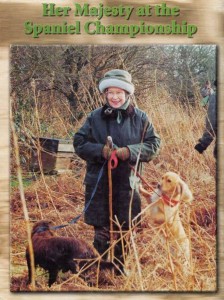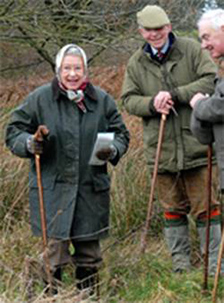Walking 100 Miles for Grouse

On the far side of 50, pushing 60, who would have thought anold guy could walk 100 miles over 11 straight days hunting grouse. The effort originated from a passion for pursuing grouse and perhapsthe first signs of senility. For sure, this hunt would be measured more in footsteps than grouse in the bag. As the scholars say anyway, it’s more about the journey than the adventure. On this journey, treasures unfold in friendships – old and new, great lessons and a few grouse along the way.
My plan included hunting three days on the Rosebud Indian Reservation in South Dakota, followed by eight days hunting innorthern Wisconsin – all focused on grouse. When I finished the prairie chicken season at Prairie Grouse Haven outfitters on November 15th, I’d drive to Birchwood, Wisconsin to reunite withan old and dear friend at his cabin in the northwoods. While I wasn’t really sure I could go the distance, I was more concerned about my spaniel pup. Izzy, just two, was in great shape and had been flushing doves all summer around our home in the Denversuburbs. She had an awesome blue grouse and mountain sharptail grouse season in Colorado. While we spent most of the autumn chasing prairie chickens, 11 straight days hunting seemed like a tall order. As it turns out, the journey would be a learning experience beyond just measuring stamina.
Our first steps were with new friends who had come to the Rosebud prairie for a hunt I was hosting. It began with a coveyflush, then a big “boomer” in the bag taken with a beautiful Damascus double by a new friend Taylor Thompson. Taylor knows more about the art of Damascus barrel-making then anyone I’ve ever met. He and his buddy, Brian Fawcett, had just come from a chukar and hun hunt to pursue prairie chickens, sharptail grouse and wild roosters with us. Funny thing now, they arrived very late – 3 o’clock a.m. and in a mini-moving van that looked likea big box on wheels. Both doctors and traveling wing shooters, these guys were sporting an armory of fine double guns. Transmission problems put them into the only rental rig left in town. They made it, and that was the good news. The fact that day two brought a second huge boomer to bag not only made a chicken fighting mount possible, it eased the inevitable discomfort of having to return “the box”. The boys had come late season for a trophy mount. The Pinea’ feathers on the boomers are fully grown by Halloween. On day three, Brian took a boomer with his John Dickinson Damascus round body double, a gun worth more than their rental rig. Since prairie grouse covey uplate in the season, we had to walk the distance for them, so I was already averaging 10 miles per day. Izzy had some excellent ushes and retrieves. Who knows how many more miles she did than us. Being only 25 pounds wouldn’t deter her ability to go the distance.

I left the prairie and drove straight through to the northwoods . . . to the chagrin of my wife and my mom who were both praying for my safety. The three old high school friends that would join me on adventure all called and gave me the spark I needed to make it. John Kollross, or Jackas he is now known, and I go back to grade school. We built a skateboard park and skateboard manufacturing business together in Milwaukee back in the late seventies. This is a guy who now goes by Jack because his girlfriend’s ex-boyfriend was named John. Oh, the things we do for love. His is a gentle spirit, now focused on lakefront properties and sporting land deals in northern Wisconsin. He was a supreme host and had good grouse habitat previously scouted. We hunted the cuts in the county and state forests around his place on Birchwood Lake. One day, I even had a rare opportunity on a red-phased ruff, but alas, it was not meant to be. I only nicked it. We searched hard – even finding blood. I then witnessed the most unusual thing. I spotted it on a log, all fanned out and strutting – a vision I won’t soon forget. I could tell he was hit. I called the dog and she promptly pounced on it and even had it in her mouth. Suddenly, that ruffed grouse produced a tremendous energy beating its wings and slipping from my pup’s grasp, only to fly off ever to be seen again. I was too flabbergasted to shoot.
Two other best friends, Steve Liebherrand Chris Baumgart, had joined us for a few days as we scoured the woodlands and discovered grouse everywhere. I hadn’t seen these guys in 40 years. It amazes me that Chris is still the same – a rock musician looking to put out his next CD. My strategy for grouse had remained the same since I was a kid growing up grouse and woodcock hunting in Wisconsin, bushwhacking a few times with Chris. Chris was pictured in the Ruffed Grouse Society magazine, Fall 2013 issue on page 37. Steve finally taught me the wisdom in walking the trails. This was a welcome lesson by day five and turned out to be the only way I could have gone the distance for the second half of my journey. Steve is a man of God and an avid Wisconsin sportsman who is wise beyond his years.The trails made it easier to walk 10 miles per day. Forest trails, logging roads and snowmobile trails crisscross this country and provide access to some excellent grouse covers. The ruffs were on the road and on the trails. I’m not sure I would call it peer pressure, but all my shots were missed and . . . missed right in front of my buddies. A lesson in humility was found. Missing like this only gives the arden twing shooter more steam to redeem oneself.
To say that there was some ribbing going on back at the cabin is an understatement. However, this served as a segue,complete with belly-roll laughter, into many old stories told around the dinner table and the replace. A treasure-trove of golden memories flooded back to me and my friends. All three of these guys had hunted grouse and deer with me at my dad’s cabin near Black River Falls when we were kids. Another lesson popped forme: No matter the reason, never let old friendships die – they are too precious. Despite many loud outbursts and laughter, Izzy slept undisturbed in the warmth of the hearth and appeared no worse for the wear.
When I finally redeemed myself, I did so using a grouse habitat map I received from a new friend Ann. Walking a trail through the perfect cut, Izzy put up two birds just off the trail. I missed the first, still too worried about getting my 30-inch prairie barrels ahead of the bird. The second ruff, however presented a phenomenal shot, albeit lucky – arching up and over the 30-foot new-growth aspenand crossing left toward a giant pine. My full choke must have caught him just as he disappeared behind the dark green. At that moment, I was not sure I had actually hit the bird. I even told the dog, “Now there might be a dead bird up here”. When I saw her get excited and run off into the forest, I wondered if she was trailing .At the site of her initial excitement, I found grouse feathers, one was still Floating in the air, and I knew she was onto something. Just as I was about to call her, she appeared with our ruffed grouse firmly in her grasp! My buddies joined in my joy as I whooped – several times. I must have just winged the bird, but Izzy did a fantastic job tracking it down many yards off into the thickness of the cut. Without her, this grouse would have eluded me.
Prior to my journey’s start, I called Ann Jandernoa of Northwind Enterprises and introduced myself. I told her that as a retired school principal, I had learned the lesson to do things smarter, not harder and wanted to get a few of her grouse habitat maps to guide my hunt. Her story fascinated me. As a forester and grouse hunter, she was bombarded over the years with requests seeking the location of ideal cuts. Her grouse habitat maps include habitat data, the age of the cut, acreage and trail identication. She has already mapped 12 states – the Midwest and many of the eastern grouse states. Her newest products are grouse habitat overlays for Google Earth and grouse habitat maps in chip format for hand-held Garmin devices. When I met her for lunch in Clam Lake, Wisconsin, she showed me how the system works on computer and GPS. While the book of maps was working for me, I was enthused about adding this technological edge.
As I drove off in search of more ruff opportunities, I pondered the brain-picking I had done with Ann. I learned that after the frosts have killed off the forest floor greens, the hens regroup together back inside the male’s territory. I smiled at the similarity of this behavior with that of their kissing cousins, the prairie chickens I love. I had recently discovered that the mature male prairie chickens or boomers, satellite off from the main covey, but never too far away. Circling around a covey flush often produces these satellite trophy birds. This strategy was employed to help my new friend Taylor claim both of his mountable boomers. After a flush, circling for ruffs in the late season is also an effective strategy. Ann shared that ruffs run, especially the mature birds and when wounded, run into the thickest cover or even down a hole. She also said that to escape,ruffs almost always fly to the densest cover, typically pines and downhill. This was exactly my experience. Also, when any moisture moves in, the ruffs go to the pines to stay dry since they don’t have much oil in their feathers. That afternooas a storm front threatened, I saw another red-phased ruff, but it flew out of a pinand did not present a shot. Th lesson: It always pays to know your grouse.
Big flakes were coming down by the time I found another old high school friend’s cabin not too far from Park Falls, Wisconsin. Gary Dunn’s lakefront cabin was already warm upon my arrival, because he had remotely started the furnace for me. Now that’s what I call a cool friend. We would meet there the following night. I knew I was getting my knack back for ruffs when the next morning, day 10, I pulled off down a national forest trailand drove until the woods looked “grousey”. While loading my gun, a ruff blew out 10 feet from me. Izzy and I circled and found two more birds close by, but none presented shots. That day I saw Lynx tracks in the snow and also tracks from a group of three wolves traveling together. I followed their tracks and discovered where they had killed a turkey. The afternoon found me walking a snowmobile trail through a nice cut when I spotted a grouse on the trail way up ahead. The birdr an into a thick spot where a bulldozer had pushed trees into a heap. I sent Izzy in there. It was so thick she couldn’t even get through. When she stopped, there was a moment of silence and then an explosion of wings. The ruff flew straight awayas fast as I can recall seeing a game bird fly. The air was still, it was twilight and the trees stood bare against the darkening sky. The gray grouse appeared as a blur in the split second I had to shoot. I chose my full-choke trigger and let it rip. In the quiet, I heard the bird hit the ground. It took me longer than expected to work around the thicket. Izzy was nowhere in sight. I stood there for a long, pregnant moment waiting on my pup. Then I saw a flash of white and orange far off in the distance. I called to her and I couldn’t believe it, she had our grouse! I thanked God for her, the grouse and my journey.
After dinner with Gary and a lot of storytelling, I woke early and set out on the final leg of my journey. It was the Friday before the annual Wisconsin deer season opener. My mom and dad were coming in from their Florida home to our family cabin. It was my mission to get my dad, at 84 years old, into his beloved deer woods one last time. I arrived early enough to hunt all the old coverts of my youth. While I easily walked 10 miles, I only saw two grouse, but one was a red-phased beauty. I flushed him three times. The first flush came right at me as Izzy worked on the back side of the bird. When it saw me, I was already getting my gun shouldered, but then it cut for a big pine. It presented itself with one wing straight up and one down as it took a sharp right turn. “Beautiful,” I thought. I shot just behind as it disappeared into the pine. I was through learning the hard way and made an oath to return with 26-inch barrels. The second flush was heard and not seen. The final flush came from the top of the pines – smart bird.
As I walked the long way back to my dad’s cabin through his woods on day 11, it dawned on me that I had walked 100 miles for grouse. On my journey, I had discovered some great lessons, treasured friendships – old and new and oh yeah, a few grouse along the way. Izzy bounded effortlessly through the woods just ahead hunting for us. I wondered how many miles she had gone – perhaps 500 or more? I felt fortunate to have such an athletic gun dog as my teammate in the field. The future would offer many hunts for us – most certainly, a return trip to the northwoods was in order. In juxtaposition, I also felt I had reached the end of an era. A sadness suddenly settled in. Accepting the fact that this was my dad’s last hunt was harder than I expected. I would be leaving for home in a few days with all of his hunting gear. I would savor every moment in his deer stand with him over the weekend and cherry pick the most memorable moments afield together. We would share many stories, yet he would not remember them all. It was in these woods that he lived the sporting life, hunting deer and grouse. The grouse had taken the biggest hold on me. I realized again that it was because of dad that I was living my own sporting life as a grouse hunter. I thanked God for my dad, his woods, my pup and the grouse. I would walk 100 miles again for grouse, but also for the journey that awaits.



